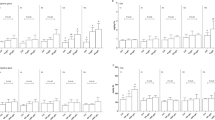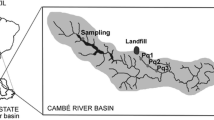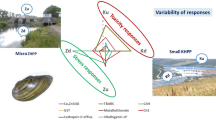Abstract
The literature indicates that exotic species have a greater tolerance to environmental stressors compared with native species. In recent decades, the introduction of contaminants into the environment has increased as a result of industrialization. The objective of this study was to verify the resistance of bivalve mollusks from freshwater native (Anodontites trapesialis) and exotic (Limnoperna fortunei) species to chemical contamination using an ex vivo/in vitro approach. Gill and muscle tissues were exposed to two different types of environmental stressors, copper (metal), and Roundup Transorb® (herbicide). The tissues were submitted to a cytotoxicity test in which the lysosomal integrity was assessed, from the adaptation of a method to isolated cells, and multixenobiotic resistance (MXR) test which evaluated cellular defense. In the exotic species, only copper at 9000 μg/L and Roundup Transorb® at 5000 μg/L were cytotoxic. In the native species, copper cytotoxicity at 900 and 9000 μg/L and Roundup Transorb® at 50 and 5000 μg/L were observed. Results were the same in both tissues. The MXR, responsible for the extrusion of contaminants (cell defense), was inhibited in both species when exposed to the contaminants, this cell defense system seems to be more inhibited in the native species, when exposed to both pollutants, indicating greater sensitivity. Therefore, cytotoxicity may be related to the lack of capacity of cellular defense. In relation to lysosomal integrity, the native species was more sensitive to cytotoxic pollutants, where a greater number of experimental conditions of metals and herbicide showed cytotoxicity, as well as more experimental situations inhibited its ability to defend itself.



Similar content being viewed by others

References
Allah AT, Wanas MWS, Thompson SN (1997) Effects of heavy metals on survival and growth of Biomphalaria glabrata Say (Gastopoda: Pulmonata) and interaction with schistosome infection. J Molluscan Stud 63:79–86
Alves MG, Oliveira PF (2014) 2,4-Dichlorophenoxyacetic acid alters intracellular pH and iontransport in the outer mantle epithelium of the bivalve Anodonta cygnea. Aquat Toxicol 154:12–18
Anjos VV, Galvão JS, VRS S, Souza MM (2016) Mesodesma mactroides gill cells exposed to copper: does hyposmotic saline increase cytotoxicity or cellular defenses? Bull Environ Contam Toxicol 97:609–613 1911–7
Babich H, Borenfreund E (1991) Cytotoxicity and genotoxicity assays with cultured fish cells: a review. Toxicol in Vitro 5(1):91–100
Barbosa FG, Wallner-Kersanach M, Baumgarten MGZ (2012) Metais traço nas águas portuárias do estuário da Lagoa dos Patos, RS. Braz J Aquat Sci Technol 16:27–36
Bard S (2000) Multixenobiotic resistance as a cellular defense mechanism in aquatic organisms. Aquat Toxicol 48:357–389
Bielen A, Vladusic T, Kuharic N, Hudina S, Sver L, Likic S (2014) First evidence of the presence of multixenobiotic resistance mechanism activity in freshwater invasive species, signal crayfish Pacifastacus leniusculus (Dana, 1852). Period Biol 116:1–7
Bielen A, Bosnjak I, Sepcic K, Jaklic M, Cvitanic M, Lusic J, Lajtner J, Simcic T, Hudina S (2016) Differences in tolerance to anthropogenic stress between invasive and native bivalves. Sci Total Environ 543:449–459
Borenfreund E, Puerner JA (1985) Toxicity determined in vitro by morphological alterations and neutral red absorption. Toxicol lett 24:119–124
CONAMA – National Council for the Environment (2005). Resolution no 357 of March 17, 2005. Ministry of the Environment
Darrigran G (2002) Potential impact of filter-feeding invaders on temperate inland freshwater environments. Biol Invasions 4:145–156
Di Donato M, Sarkar B (1997) Copper transport and its alterations in Menkes and Wilson diseases. Biochem Biophys Acta 1360:3–16
Freshney RI (2005) Culture of animal cells - a manual of basic technique, 5ª edn. Wiley-Liss, New York
Fukuda M (1991) Lysosomal membrane glycoproteins. J Biol Chem 266(32):21327–21330
Gomes T, Pinheiro JP, Cancio I, Pereira CG, Cardoso C, Bebianno MJ (2011) Effects of Copper Nanoparticles Exposure in the Mussel Mytilus galloprovincialis. Environmental Science Technology 45:9356–9362
Goulart TLS, Boyle RT, Souza MM (2015) Cytotoxicity of the association of pesticides roundup Transorb® and Furadan 350 SC® on the zebrafish cell line, ZF-L. Toxicol in Vitro 29:1377–1384
Karatayev AY, Burlakova LE, Padilla DK, Mastisky SE, Olenin S (2009) Invaders are not a random selection of species. Biol Invasions 11:2009–2019
Katsumiti A, Thorley AJ, Arostegui I, Reip P, Valsami-Jones E, Tetley ET, Cajaraville MP (2018) Cytotoxicity and cellular mechanisms of toxicity of CuO NPs in mussel cells in vitro and comparative sensitivity with human cells. Toxicol in Vitro 48:146–158
Kurelec B (1995) Inhibition of multixenobiotic resistance mechanism in aquatic organisms: ecotoxic consequences. Sci Total Environ 171:197–204
Kurelec B, Smital T, Pivcevic B, Eufemia N, Epel D (2000) Multixenobiotic resistance, P-glycoprotein, and chemosensitizers. Ecotoxicology 9:307–327
Lajtner J, Crncan P (2011) Distribution of the invasive bivalve Sinanodonta woodiana (Lea, 1834) in Croatia. Aquat Invasions 6(1):119–124
Lowe DM, Soverchiab C, Moore MN (1995) Lysosomal membrane responses in the blood and digestive cells of mussels experimentally exposed to fluoranthene. Aquat Toxicol 33:105–112
Modesto KA, Martinez CBR (2010) Roundup causes oxidative stress in liver and inhibits acetylcholinesterase in muscle and brain of the fish Prochilodus lineatus. Chemosphere 78:294–299
Nunes SM, Josende ME, González-Durruthy M, Ruas CP, Gelesky MA, Romanod LA, Fattorinie D, Regoli F, Monserrat JM, Ventura-Lima J (2018) Different crystalline forms of titanium dioxide nanomaterial (rutile and anatase) can influence the toxicity of copper in golden mussel Limnoperna fortunei? Aquat Toxicol 205:182–192
Oliveira P, Lopes-Lima M, Machado J, Guilhermino L (2015) Comparative sensitivity of European native (Anodonta anatina) and exotic (Corbicula fluminea) bivalves to mercury. Estuar Coast Shelf Sci 167:191–198
Piola RF, Johnston EL (2006) Differential tolerance to metals among populations of bryozoan Bugula neritina. Mar Biol 148:997–1010
Pytharopoulou S, Kournoutou GG, Leotsinidis M, Georgiou CD, Kalpaxis DL (2013) Cadmium versus copper toxicity: insights from an integrated dissection of protein synthesis pathway in the digestive glands of mussel Mytilus galloprovincialis. J Hazard Mater 260:263–271
Regoli F (2000) Total oxyradical scavenging capacity (TOSC) in polluted and translocated mussels: a predictive biomarker of oxidative stress. Aquat Toxicol 50:351–361
Repetto G, Del PA, Zurira JL (2008) Neutral red uptake assay for the estimation of cell viability/cytotoxicity. Nat Protoc 3:1125–1131
Ricklefs RE (2010) The economy of nature, 6ª edn. Publisher Guanabara Koogan, Rio de Janeiro
Rocha CT, Souza MM (2012) The influence of lead on different proteins in gill cells from the freshwater bivalve, Corbicula fluminea, from defense to repair biomarkers. Arch Environ Contam Toxicol 62:56–67
Sabik H, Jeannot R, Rondeau B (2000) Multiresidue methods using solid-phase extraction techniques for monitoring piority pesticides, including triazines and degradation products, in ground and surface waters. Journal of Chromatography A 885:217–236
Santos KC, Martinez CBR (2014) Genotoxic and biochemical effects of atrazine and Roundup, alone and in combination on the Asian clam Corbicula fluminea. Ecotoxicol Environ Saf 100:7–14
Schwake M, Schroder B, Saftig P (2013) Lysosomal membrane proteins and their central role in physiology. Traffic 14:739–748
Smital T, Luckenbach T, Saureborn R, Hamdoun AM, Vega RL, Epel D (2004) Emerging contaminants—pesticides, PPCPs, microbial degradation products and natural substances as inhibitors of multixenobiotic defense in aquatic organisms. Mutat Res 552:101–117
Wanga L, Zhoub L, Fanb D, Wangb Z, Gub W, Shib L, Liub J, Yang J (2019) Bisphenol P activates hormonal genes and introduces developmental outcomes in Chironomus tentans. Ecotoxicol Environ Saf 174:675–682
Weir SM, Salice CJ (2012) High tolerance to abiotic stressors and invasion success of the slow growing freshwater snail, Melanoides tuberculatus. Biol Invasions 14:385–394
Author information
Authors and Affiliations
Corresponding author
Additional information
Responsible editor: Philippe Garrigues
Publisher’s note
Springer Nature remains neutral with regard to jurisdictional claims in published maps and institutional affiliations.
Rights and permissions
About this article
Cite this article
El Haj, Y., Bohn, S. & Souza, M.M. Tolerance of native and invasive bivalves under herbicide and metal contamination: an ex vivo approach. Environ Sci Pollut Res 26, 31198–31206 (2019). https://doi.org/10.1007/s11356-019-06256-x
Received:
Accepted:
Published:
Issue Date:
DOI: https://doi.org/10.1007/s11356-019-06256-x



